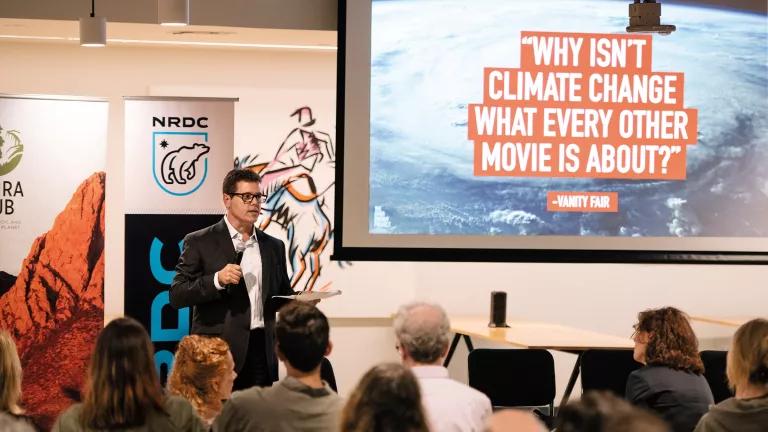Lights, Camera, Action on Climate
Daniel Hinerfeld is partnering with TV and film writers, producers, and other Hollywood creatives to address climate change on-screen.

Hinerfeld presenting at a discussion about Hollywood and the climate crisis at the Pacific Design Center
Jose Mandojana/Docuvitae for NRDC
If Daniel Hinerfeld, NRDC’s director of content partnerships, gets his way, millions of television viewers could soon be watching a show that opens something like this.
Scene: Interior Suburban Home—Dimly Lit Bedroom
A thirtysomething man and woman sit in bed, watching TV news coverage of wildfires ravaging homes. The couple is visibly distressed. The man turns off the TV and falls back on the bed with a loud sigh.
MAN
I mean . . . what will the world be like in 50 years—or even 10? I want to have kids.
WOMAN
Falls back beside him.
Are we crazy for trying?
“We’re building an initiative in Hollywood to increase climate storytelling,” says Hinerfeld, who works out of NRDC’s Los Angeles office. “We’re reaching out to creative professionals and celebrities, not to ask them to speak up personally but rather to change what they’re doing professionally a little bit—to focus on the climate crisis in their art.”
Hinerfeld has worked with the entertainment industry for nearly two decades to raise public awareness of environmental issues and harness the power of Hollywood to influence change. In 2016, he codirected and coproduced Sonic Sea, a documentary about the vast harm to marine life from industrial and military ocean noise. The film won two 2017 Emmy awards, premiered globally on the Discovery Channel, and was screened at film festivals around the world.

He is quick to note that NRDC has a long and storied history with pop culture, ever since Robert Redford turned the New York premiere of his 1976 film, All the President’s Men, into a benefit for the organization. Over the past five decades, James Taylor, Sigourney Weaver, Rashida Jones, Hasan Minhaj, and other celebrities have played important roles for NRDC, helping to raise support and inspire new activists.
Hinerfeld hopes that this new effort will build on their work. “We want to broaden our audience and reach people in a different way that may change their behavior and attitudes, particularly about climate change,” he says. In particular, he hopes that more Hollywood stories about the climate crisis will engage those people who still don’t accept the reality of climate change, as well as “the rest of us who accept the reality but live as if we don’t.” Openly portraying characters grappling with these issues on-screen is a critical first step to helping an audience overcome denial about the struggle we’re facing.
But just showing the depth of the climate crisis on television won’t be enough, Hinerfeld says. To ensure that viewers don’t just shut down, media producers also need to show them a path forward and give people hope that we can avert catastrophe by taking action. NRDC’s content partnerships team has been working to inspire media executives to take more responsibility for guiding public opinion in this way, through in-person meetings with writers, showrunners, networks, and studios; via public forums; and even by helping to develop new film and TV projects.
“Before we talk with creative professionals, we study their shows and think about how climate change could intersect with the characters, settings, and themes of the show,” Hinerfeld says. “We come in with ideas, questions, and research that can help spark the imaginations of writers.” Climate storytelling could be reflected through both small moments—like a character plugging in an electric car at a public charging station—and bigger ones, like a character making a choice about a job or a relationship that relates to climate change.
The recent shift in the business of television has made room for NRDC to step into this role. Network TV depends on advertisers, many of whom are in the fossil fuel business or related industries and do not want programming about climate change. But the rise of premium cable and streaming content providers—which often don’t show commercials—has allowed more freedom for writers. “The companies that make subscription-based content are a lot less interested in what the fossil fuel industry or the auto industry thinks about climate stories,” Hinerfeld says.
“We have only a few years left to head off possibly runaway climate change,” he continues. “In order to do that, we need the help of every sector of society, because what is required is a massive shift in the attitudes and behavior of tens of millions of people.” Now that’s a plot twist worth watching.
This NRDC.org story is available for online republication by news media outlets or nonprofits under these conditions: The writer(s) must be credited with a byline; you must note prominently that the story was originally published by NRDC.org and link to the original; the story cannot be edited (beyond simple things such as grammar); you can’t resell the story in any form or grant republishing rights to other outlets; you can’t republish our material wholesale or automatically—you need to select stories individually; you can’t republish the photos or graphics on our site without specific permission; you should drop us a note to let us know when you’ve used one of our stories.
1.5 Degrees of Global Warming—Are We There Yet?
How to Find Relief During Summer Heat Waves in the City
Flooding and Climate Change: Everything You Need to Know